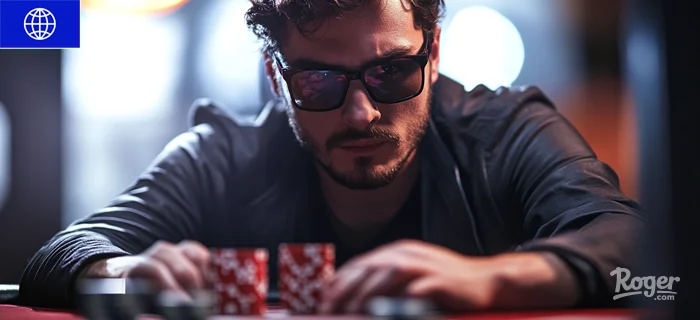Now, you can gamble from anywhere—allowing people to become poker professionals from their living rooms.
👉 However, playing table games like poker online differs from playing in a real casino.
Players accustomed to live poker may find the virtual version tricky and unpredictable, particularly when it comes to bluffing. Many wonder if bluffing is even possible in online poker without physical tells or body language.
Yet bluffing remains a key strategy in online poker, but it requires a different approach. Without physical tells, players must rely on alternative techniques. Let’s dive into these poker strategies.
Table of contents
Observing the table: Identifying digital tells
While live poker allows players to detect facial expressions, hand movements, and nervous habits, online poker requires more strategic observation, as every action a player takes tells a story.
Here are key digital tells to watch for:
- Betting patterns — Some players raise in specific situations, while others frequently fold under pressure. Recognise these habits to predict their reactions.
- Response time — A quick call often signals a strong hand, while long hesitations can indicate uncertainty or a bluff in progress.
- Folding behaviour — Players who fold easily under aggression are prime bluffing targets, and those who rarely fold are likelier to call your bluff.
Be mindful of your actions, as all players can see your decisions. If your bluffing is too obvious, experienced players will quickly counter, leaving you without a win.
Non-GamStop online casinos, according to eSportsInsider, provide poker players with opportunities to refine their skills without the limitations imposed by UK self-exclusion programs. This way, you can have fewer restrictions on bluffing strategies and gameplay styles.
Choosing the right opponent to bluff
Not all opponents are easy to bluff. The effectiveness of a bluff depends on the players' skill level, tendencies, and psychology.
Experienced players can easily detect a bluff, while rookies, particularly those more hesitant, may fold easily under pressure.
To increase your chances of success, it’s crucial to know when and how to apply bluffing tactics to master the game.
Here’s a quick recap:
How to spot players who are hard to bluff
- They usually call bluffs and challenge other players;
- They usually analyse betting patterns and adjust strategies mid-game;
- They always confidently raise, and don’t hesitate before making decisions.
How to identify bluffing targets
- They typically hesitate before making large bets or raises;
- They usually fold when faced with aggression;
- They avoid high-risk plays.
😎 Pro tip: A smart bluffer focuses on one or two players at a time. Bluffing against multiple experienced opponents at once increases the risk of exposure.
The power of consistency in bluffing
One of the most overlooked aspects of successful bluffing is consistency. Although it may seem unreasonable sometimes, maintaining a steady betting pattern makes it more difficult for opponents to detect a bluff.
For example, if a player frequently checks with weak hands but suddenly bets aggressively, it raises suspicion.
On the other hand, if a player bluffs too often, opponents will catch on and begin to call them out.
Lastly, if a player rarely bluffs but suddenly goes all-in, it can indicate a predictable playstyle.
A skilled bluffer knows when to stick to their strategy and when to adjust. If a bluff falls flat, folding and waiting for a better chance is best.
The importance of position in online bluffing
Position at the table is one of the most underrated factors in successful bluffing.
In poker, position refers to when a player acts in relation to others—whether they’re first, last, or somewhere in between.
‼️ Bluffing from an early position is risky because you don’t yet have enough information about how your opponents will respond.
In contrast, bluffing from a late position is much safer; you can observe how many players remain in hand and how they are betting, which makes it easier to predict the success of your bluff.
When you’re in a small or big blind, bluffing can be effective, particularly if your opponents are weak or passive. However, for this strategy to move, it is essential to understand other players' tendencies.
Common bluffing mistakes to avoid
Sometimes even the most experienced players miscalculate their bluffs. But you can lower your mistakes by becoming more aware of them,
To increase your chances of success, here’s a list of common pitfalls to avoid:
- Bluffing too frequently — Bluffing too often makes it easy for opponents to detect your pattern.
- Bluffing in bad positions — Bluffing when out of position (acting first) often leads to failure.
- Ignoring table dynamics — It is riskier to bluff against highly skilled players than targeting cautious opponents.
- Inconsistent patterns — Sudden changes in your betting behaviour can reveal a bluff.
Final thoughts
Bluffing is a fundamental skill in poker, whether you play it online or in a real casino. Even though digital poker lacks physical tells, there are some unique strategies that you can apply for successful bluffing.
👌 If you carefully analyse betting patterns, choose the right opponents, maintain consistency, and master the importance of position, you can successfully pull off strategic bluffs.
Remember that the best bluffs go undetected, and the stronger poker players balance deception with smart and strategic playing.
Learn more about poker and other casino games now via the Roger blog.





